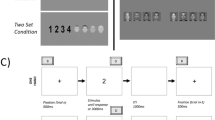Abstract
This article describes a quantitative model, which suggests what the underlying mechanisms of cognitive control in a particular task-switching paradigm are, with relevance to task-switching performance in general. It is suggested that participants dynamically control response accuracy by selective attention, in the particular paradigm being used, by controlling stimulus representation. They are less efficient in dynamically controlling response representation. The model fits reasonably well the pattern of reaction time results concerning task switching, congruency, cue-target interval and response-repetition in a mixed task condition, as well as the differences between mixed task and pure task conditions.
Similar content being viewed by others
Author information
Authors and Affiliations
Additional information
Received: 31 March 1999 / Accepted: 23 July 1999
Rights and permissions
About this article
Cite this article
Meiran, N. Modeling cognitive control in task-switching. Psychological Research Psychologische Forschung 63, 234–249 (2000). https://doi.org/10.1007/s004269900004
Issue Date:
DOI: https://doi.org/10.1007/s004269900004




